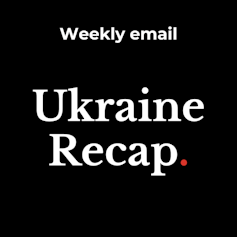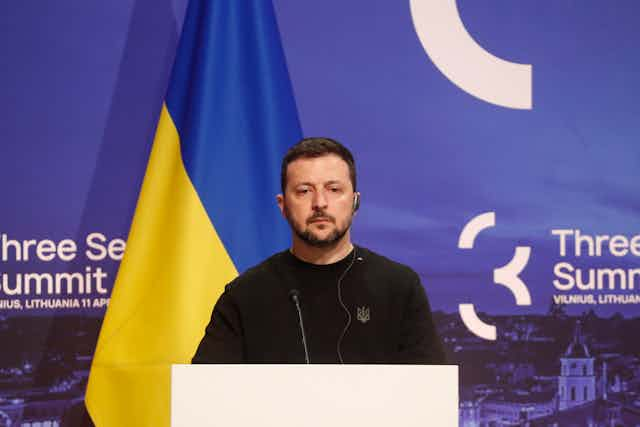The air war in Ukraine has intensified considerably over the past few months, with a dramatic increase in the number of sorties being flown by Russia’s airforce. Some observers believe that, having gained a degree of initiative on the ground – for example, with the capture of the strategically important city of Avdiivka in the eastern Donetsk region – the Kremlin’s war planners want to capitalise on this by maintaining the momentum.
Accordingly, Russia has intensified its assault on Ukraine’s defences, while maintaining the attacks on power infrastructure that have been a key strategy since it launched its invasion in February 2022.
The latest blow was the destruction, on April 11, of the largest power-generating plant in Ukraine’s Kyiv region. The Trypilska thermal power plant (TPP) was the largest supplier of electricity to the Kyiv, Cherkasy and Zhytomyr regions. It was the last of three major plants run by power generation company Centrenergo still in operation – one in the Donetsk region was occupied by Russian troops in the summer of 2022, and the second, in Kharkiv, was destroyed in a Russian attack in March.
There has been little, if any, good news for Ukraine’s war planners in recent months, writes Christopher Morris of the University of Portsmouth. Morris, an expert in military strategy, points to recent Russian advances west of Avdiivka and other pressure points along Ukraine’s frontlines as evidence of increasing Russian confidence that the tide might be turning their way.

Morris believes that now more than ever, Kyiv’s western allies need to heed the pleas of Ukraine’s president, Volodymyr Zelensky, as he begs them to send more weapons. Time is not on his side. The Washington Post recently ran a story detailing what it called Donald Trump’s “secret, long-shot plan to end the war in Ukraine”, which would involve “pushing Ukraine to cede Crimea and the Donbas border region to Russia”.
There’s no indication from Zelensky that he’d give any of Trump’s suggestions houseroom – and it also appears extremely unlikely from what Vladimir Putin has said that the Russian president would want to stop there anyway. But if Trump does win the US presidential election in November, it seems very unlikely that Kyiv can continue to count on US help. And that would shift the balance decisively in Russia’s favour.
Read more: Ukraine war: battlefield tipping in Russia's favour as Kyiv begs allies for more arms
As we have noted before in our coverage of the conflict, Russia has successfully transitioned its economy on to a wartime footing, and its armaments industry is now operating to a capacity greater than many experts believed it was capable of two years ago.
Moscow has also proved to be good at adapting and improving its stock of Soviet-era weaponry for use on the modern battlefield. An example of such ingenuity is the way its technicians have adapted its old “dumb bombs”, basically unchanged since the second world war – the sort of munitions you dropped from an aircraft overflying a target – into what are known as “glide bombs”.
As military historian Gerald Hughes of the University of Aberystwyth writes, glide bombs are dumb bombs with wings and a fairly rudimentary guidance system attached. They have a range of about 70km and are much cheaper than other air-launched missiles. Russia’s use of these guided missiles has increased by 1,600% over the past 12 months, with the result that Ukraine’s defences – and cities such as Kharkiv – are taking a pounding.
Meanwhile, Zelensky continues to plead for arms. And if the US politicians dragging their heels over signing Joe Biden’s aid package into law need a really potent message that Ukraine requires more and better air defence systems, then the havoc being caused by these relatively cheap and unsophisticated weapons should be enough.

Since Vladimir Putin sent his war machine into Ukraine on February 24 2022, The Conversation has called upon some of the leading experts in international security, geopolitics and military tactics to help our readers understand the big issues. You can also subscribe to our fortnightly recap of expert analysis of the conflict in Ukraine.
Our colleagues in the US have published an article by Tatsiana Kulakevich, a scholar of eastern Europe at the University of South Florida, which delves into the politics being played out in the US over providing arms to Ukraine. Kulakevich believes the US is very unlikely to abandon Ukraine to its fate.
One reason is the increased threat this will pose for Nato, whose member states sharing a border with Russia are already extremely nervous about the prospect of an emboldened Putin, flushed with military success, taking advantage of an isolationist US to indulge in further military adventures.
But Kulakevich also points to the steady and inexorable rise of China as another reason the US can’t afford to assume an isolationist position. Put simply, Washington needs Europe to compete with Beijing. She quotes US Navy admiral Samuel J. Paparo, who said in February 2024 that Russia’s potential loss in Ukraine is “a deterrence in the western Pacific and directly reassures partners”.
Nervous Nato gears up
The possible reelection of Trump as US president is focusing minds across Nato. You may remember Trump quipped back in February that he would “encourage” Russia to attack any of the US’s Nato allies whom he considers not to have paid their fair share of the budget.

While he later dismissed this as campaign hyperbole, most observers believe that Trump is less interested in European security and the fortunes of the Nato alliance – which recently celebrated 75 years without a major war in Europe – than any of his predecessors, and certainly the current incumbent.
Michelle Bentley, a reader in international relations at Royal Holloway University of London, believes that Nato members need to “Trump-proof” their defence policies as a matter of urgency. She says European countries need to increase their defence spending to cold war levels, and that more cooperation to reduce the alliance’s dependence on the US will also be important.
While there are signs this is already happening, Bentley says that, as November approaches, it will increasingly be a priority.
Read more: Waiting for Trump to be re-elected is wrong – Nato leaders need to Trump-proof their policies now
Another sign of how seriously some of Russia’s neighbours are taking the threat of an emboldened Putin is the fact that many countries are either beefing up their conscription policies or thinking about doing so.
Rod Thornton, a defence expert at King’s College London, has been looking at conscription and national service policies across a range of European countries, and writes that the war in Ukraine has served as spur for the reintroduction of the call-up across the continent. France and Germany, which both got rid of conscription (Germany as recently as 2011), are now talking about reintroducing it.
Sweden, which recently joined Nato, dropped conscription in 2018 but has brought it back while introducing what it calls its “total defence service”. This will increase the number of people called into uniform from 4,000 a year to 100,000. The Baltic countries, which feel particularly vulnerable as a result of sharing a border with Russia, are all reviewing their conscription numbers.
There’s even been talk of bringing back national service in the UK, with newspaper columnists citing falling numbers in Britain’s armed forces as an example of how far the country has fallen as a military power. Thus far, though, it remains just that: talk.
China and Russia cosy up
Days before Putin sent his war machine into Ukraine, he met with Chinese president Xi Jinping on the sidelines of the Beijing Winter Olympics, where the pair posed for photos and declared a “no-limits friendship”. Now, we’re told, the two countries have taken this even further (if this were rhetorically possible) after Russia’s foreign minister, Sergey Lavrov, travelled to meet his Chinese counterpart, Wang Yi, in Beijing this week.
We asked Natasha Kuhrt, an international security expert from King’s College London, what messages the west should draw from what we know about their conversation. Her verdict is that increased cooperation between the two countries, which pointedly talked of the west’s “cold war thinking” and US “bullying”, should be taken very seriously indeed.
She concludes: “At the 2022 Madrid summit, Nato belatedly acknowledged the importance of the Russia-China relationship, and the worst-case scenario of a two-front war. This meeting does not diminish those fears.”
Read more: How have China and Russia beefed up their relationship after Ukraine war wobble? Expert Q&A
Ukraine Recap is available as a fortnightly email newsletter. Click here to get our recaps directly in your inbox.

